
The tucuxi dolphin (pronounced ‘too-koo-shee’), aka bufeo gris, bufeo negro, estuarine dolphin, grey dolphin, grey river dolphin, or Guianian river dolphin, can be found throughout the Amazon River and the Orinoco River systems. The marine subspecies can be found along the eastern coast of South America (from Brazil to Nicaragua), in the Caribbean Sea, in the Atlantic Ocean. Due to the threats of habitat loss and destruction at the hands of residential and commercial developments, and dam constructions; overfishing; and pollution, these beautiful creatures are listed as Endangered by the IUCN. Their populations are also decreasing.
First the Stats…
Scientific name: Sotalia fluviatilis
Weight: Up to 121+ lbs.
Length: Up to 6.5 feet
Lifespan: Up to 35 years
Now on to the Facts!
1.) These social creatures can be found in pods of up to 60 individuals, but it’s more common to see pods of up to 15 individuals.
2.) Calves will usually dwell in larger pods in order to obtain valuable life skills from the others.
3.) While they can hold their breathe for longer, 30 seconds tends to be the typical submerged time.
4.) They are diurnal (active during the day) and are usually spotted in the early morning and afternoon.
5.) Generally shy, these dolphins don’t usually jump from the water, but can, if the mood strikes them, and are typically slower swimming.
But wait, there’s more on the tucuxi dolphin!
6.) Echolocation is utilized as both a means to navigate and communicate.
7.) They also communicate via a variety of whistles and clicks. The variety of these sounds are used to alert the others in their pod of food, threats, and the intent to mate.
Did you know…?
In the south Caribbean Sea, the tucuxi is the most common cetacean to be caught in gill nets by coastal fisheries.
8.) A group of dolphins is called a herd, pod, or school.
9.) They primarily feed on ray-finned fishes, octopuses, and squid.
10.) It is believed that these dolphins are polyandrous (1 female mates with several males).
But wait, there’s still more on the tucuxi dolphin!
11.) Mating season lasts from August – October.
12.) Calves are typically born during the low-water season, in autumn.
Did you know…?
Intelligent as dolphins are, these critters have been documented engaging in play behavior; playing with aquatic plants, each other, and with aquatic turtles – much to the turtle’s dismay.
13.) Females undergo up to a 11.6 month gestation (pregnancy) that yields a single calf.
14.) Sexual maturity is obtained at around 6 years of age.
15.) Dam construction is a huge threat to tucuxi dolphins due to habitat fragmentation (which affects both the dolphins and their food source – migratory fish), and dams also confine populations within certain areas, which can cause inbreeding to occur.
Now a Short Tucuxi Dolphin Video!
Be sure to share & comment below! Also, check out the Critter Science YouTube channel. Videos added regularly!
Want to suggest a critter for me to write about? Let me know here.
Some source material acquired from: Wikipedia & IUCN
Photo credit: WDC



